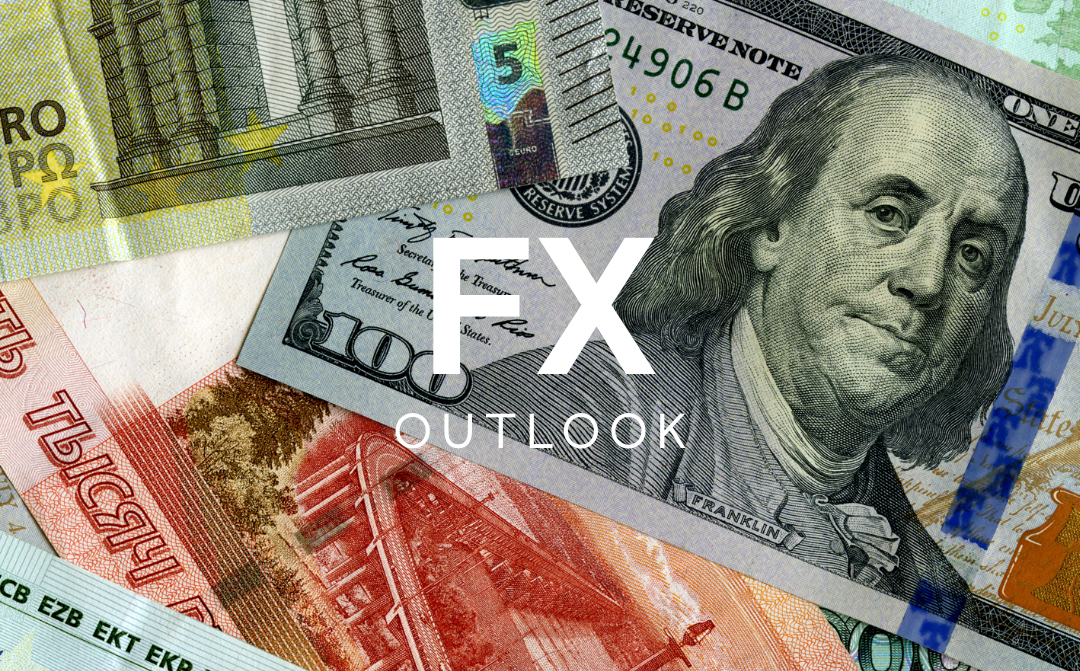27 Nov FX outlook – USD, EUR, GBP, CAD, AUD, NZD

Table of Content
US dollar (USD)
For the second week in a row, the US dollar fell against other major currencies as a cautious Fed and concerning economic indicators fueled speculation about an early rate reduction in 2024. The dollar index slipped into the lowest level since late-August, with a Wednesday pop being reversed in the latter part of the week.
The USD had a quiet start to the week as investors were anticipating the outcome of Tuesday’s FOMC meeting minutes. The USD was able to strengthen after Fed policymakers stated that inflation remained above their 2% target with additional rate hikes considered if inflationary pressures persisted. The decline in unemployment claims from the previous month (209K vs 233K) and an increase in November consumer confidence (61.3 vs 60.4) bolstered the case for keeping interest rates at restrictive levels for longer. However, a drop in core Durable Goods Orders (-0.0% vs 0.4%), and a move back into contraction for the manufacturing PMI (49.4) survey rekindled calls for a swift H1 2024 move to cut rates, weighing on the US dollar.
Moving on, investors will continue to follow top-tier data reports due this week, which might have a significant impact on the US dollar. The impact of an overly tight economy will be seen in Tuesday’s consumer confidence report, as spending habits are projected to drop. Furthermore, the preliminary GDP report for the quarter could provide volatility although this is a revision of the 4.9% figure released in October. Finally, additional Fed discussions, particularly from Jay Powell, might see USD bulls spring into action if he takes a more hawkish tone in a bid to quell calls for a swift return to monetary easing.
Euro (EUR)
The EUR has been plagued by inconsistency, moving in the opposite direction from a fortnight ago, with poor performance against the NZD, GBP, and AUD. However, the euro finished modestly better against the US dollar and the Japanese yen. Much of the euro’s problems have been attributed to a shaky economic outlook in the euro area, which has recently begun to improve.
Last week saw a decline in the monthly German PPI figure, further weakening the inflation picture for the region. However, the single currency was given a ray of light as PMI figures from across the eurozone inspired confidence about economic revival. Germany, Europe’s economic powerhouse, showed an increase in PMI surveys, indicating a gradual easing of the economic downturn. Furthermore, the eurozone Flash PMI surveys indicated improved readings, even though the data remained in the contraction zone. Following that, the drop in German GDP numbers weakened economic expectations.
With more to come in the week ahead, the EUR will be looking forward to potential volatility from several economic indicators which include ECB comments and inflation updates from the euro area, Germany, and Spain. With both headline and core inflation expected to continue their downward trajectory, any failure to maintain that trend could raise concerns over the timing of the move back down to target. Also keep an eye out for the latest PMI surveys from Italy and Spain due on Friday, with both expected to follow last week’s trend of pushing higher despite the ongoing contraction.
Great British Pound (GBP)
The pound enjoyed a healthy week of gains against many of the major currencies, with the havens particularly feeling the pressure against the pound. Declines in energy markets helped drive GBPCAD higher, while GBPUSD, GBPJPY, and GBPCHF also enjoyed plenty of upside. In Europe, money favoured the euro, with EURGBP on the rise ahead of this weeks eurozone inflation gauge.
Last week saw the Chancellor deliver his Autumn Statement, with markets more concerned with ONS inflation and growth forecasts than the promises of a cut to the national insurance rate. The ONS projections saw the timing of a return to 2% pushed back by a year, with the group instead looking for prices to fall back to target by 2025. This helped spur greater calls for an additional rate hike from the Bank of England. Meanwhile, Thursday’s PMI report had the same effects, with improved data across both manufacturing and services helping to drive the composite figure back up into expansion territory. Notably, the services sector saw a significant uptick in prices, highlighting how firms were having to ramp up wages which in turn pushes prices upward. Markets are now pricing in a first rate cut in September 2024, which is a marked change from the 50% chance allocated to the June meeting just a week ago.
Looking ahead, this week sees little by way of major market moving economic data releases out of the UK. Tuesday does provide a lesser-known inflation gauge, with the BRC shop price index providing a leading signal of the prices being paid by consumers. A continuation of that trend could bring about EURGBP strength. Also keep an eye out for the latest comments from Bank of England Governor Bailey on Thursday, with the recent PMI strength providing the basis for further tightening if the MPC deem it necessary. Recent comments have seen him state that the path to 2% inflation will be hard work, with any talk of rate cuts being premature given current pricing pressures.
Canadian Dollar (CAD)
The Canadian dollar saw a choppy week, with the currency struggling to battle back against falling energy prices. That tale of two-halves saw EURCAD, USDCAD, AUDCAD and NZDCAD all fade their Monday gains over the course of the week. The CAD rose to a one-month high against the USD, which continues to find itself under pressure as improved market sentiment pushed US indices into a fourth weekly gain.
As the race to drop rates by 2024 gains steam, recent inflation data from Canada has tipped the BoC to start relaxing policy ahead of its rivals. In October, Canada’s annual inflation rate decreased unexpectedly to 3.1%, while core inflation fell marginally to 2.7%. At a recent meeting, BOC Governor Tiff Macklem stated that the bank remains willing to raise rates further if necessary although markets see little chance of that occurring (0%). In fact, we already see a 13% chance of a December cut according the latest Refinitiv data. Nonetheless, a stronger-than-expected retail sales report (0.6% vs 0.0%) helped drive home the potential for a more cautious approach as noted by Macklem. Crude oil, Canada’s main export, resumed its price drop, shedding roughly 1.21% in value ahead of the OPEC+ meeting to agree on production cuts for 2024.
In the coming week, the CAD will be affected by market volatility due to certain high-impact economic data. The Canadian economy will be hoping for move back into positive growth in September, following two consecutive 0% figures in July and August. The OPEC meeting on Thursday will be key, with recent doubts over the strength of OPEC’s resolve to maintain production cuts coming into question. Also keep an eye out for the latest Canadian jobs report scheduled on Friday, with any uptick in unemployment or wages bringing potential concerns of a more hesitant approach to easing from the BoC.
Australian Dollar (AUD)
The Australian dollar enjoyed yet another week of strength, with the currency continuing its push higher in what looks to be shaping up as potentially the best month of the year for AUDUSD. This is largely associated with a wider risk-on play, with havens losing ground in favour of pro-cyclical currencies such as the Aussie dollar. However, it is also a reflection of falling yields in comparison with the Australian 10-year. With the Australian CPI currently standing at 5.4%, there is still a chance we see additional tightening from the RBA. That being said, we are seeing a shift towards limiting the chance of another hike, with the government looking to pass a bill which would set the RBA a dual mandate of both price stability and full employment.
Last week saw commentary from the RBA Governor Bullock, who continues to see elevated inflation pressures for the majority of goods and services. Her statement that it would take time to get demand driven inflation back down towards the 2-3% target does highlight a willingness to stay the course if necessary. The RBA minutes struck a similar tone, with members concerned that businesses see demand as being strong enough that any increase in costs will be pushed onto the consumer. While markets are cautious over the idea of another hike in December (12%), there is an expectation that we will see a final push higher in the new year. According to Refinitiv, markets currently assign a 56% chance of another hike in March. This puts them in stark contrast to the likes of the FOMC, which is expected to potentially cut rates as early as June. Last week also saw the latest PMI data, with both services and manufacturing sectors moving further into contraction territory.
Looking ahead, the potential for a bill on transitioning the RBA onto a dual mandate will be key, as this could impact expectations for another rate hike. That being said, with Australian unemployment standing at 3.7%, it could be argued that such a dual mandate wouldn’t restrict any additional tightening as things stand. Keep a close eye out for the Australian inflation data due out on Tuesday night, with markets looking for another move lower for this key metric. A particularly strong move for inflation could bring AUD volatility into play, shifting market expectations for further tightening from the RBA.
New Zealand Dollar (NZD)
The New Zealand dollar represented the weeks winner, with the currency gaining ground across the board. With money moving into risk assets, we have seen dollar weakness and NZD strength push NZDUSD into a fresh three-month high. Particular gains came against haven assets such as the Yen and dollar, but we also saw the euro and pound lose ground against the Kiwi.
Last week saw the New Zealand trade data improve, although the deficit came in well below market expectations. Export prices did improve somewhat, which the GDT dairy figure moving back to 0% after the previous reading of 0.7%. Thursday’s third-quarter retail sales gauge similarly showed signs of improvement, with the core figure rising to the best figure since early 2022 (1%).
Looking ahead, this week sees the RBNZ return for their latest monetary policy decision on Tuesday night. Markets currently price a mere 6% chance of a rate hike, with the focus instead turning towards the potential first rate cut next year. As such, keep an eye out for commentary around this decision given the impact they can have on expectations. As things stand, the first hike is being priced in for August. Also keep an eye out for the latest PMI data due, with this gauge providing a key signal of economic strength for the New Zealand economy.
Disclaimer: This material is a marketing communication and shall not in any case be construed as an investment advice, investment recommendation or presentation of an investment strategy. The marketing communication is prepared without taking into consideration the individual investors personal circumstances, investment experience or current financial situation. Any information contained therein in regardsto past performance or future forecasts does not constitute a reliable indicator of future performance, as circumstances may change over time. Scope Markets shall not accept any responsibility for any losses of investors due to the use and the content of the abovementioned information. Please note that forex trading and trading in other leveraged products involves a significant level of risk and is not suitable for all investors.







